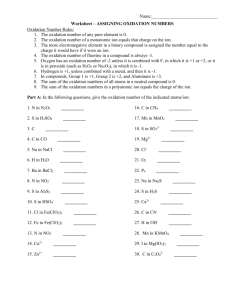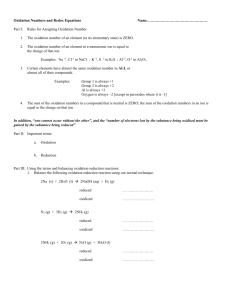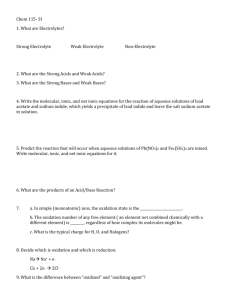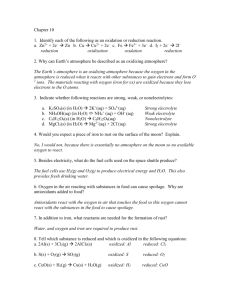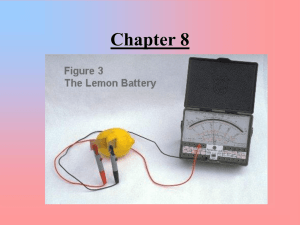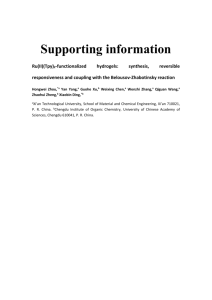The Effect of Oxidation on the Subsequent Oven
advertisement
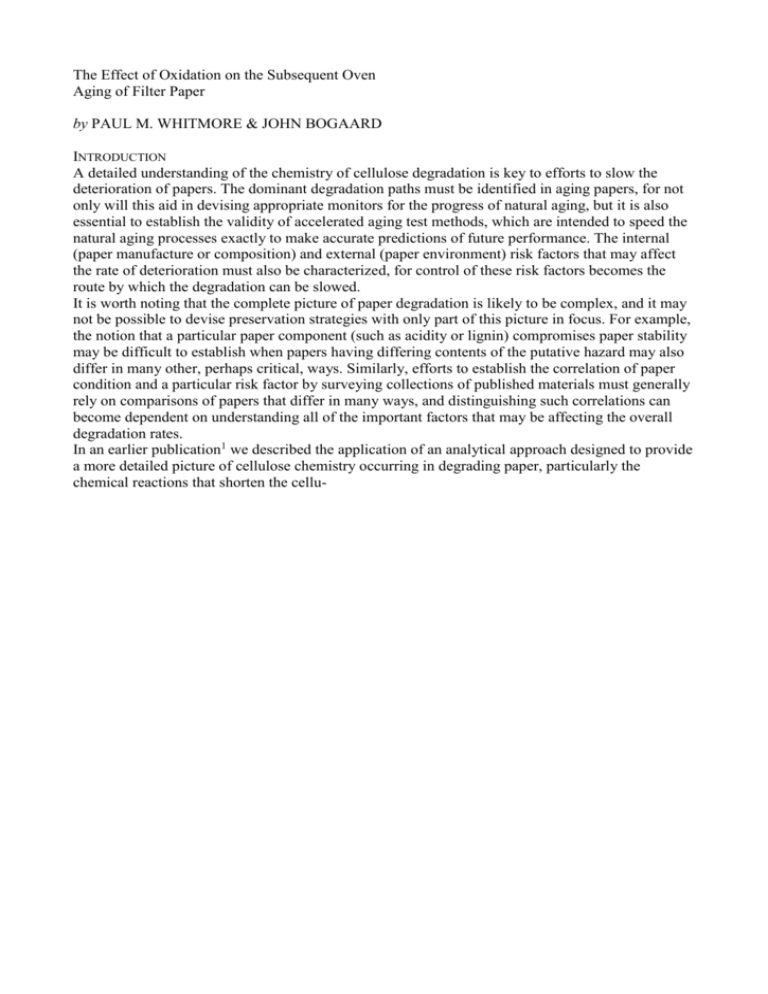
The Effect of Oxidation on the Subsequent Oven Aging of Filter Paper by PAUL M. WHITMORE & JOHN BOGAARD INTRODUCTION A detailed understanding of the chemistry of cellulose degradation is key to efforts to slow the deterioration of papers. The dominant degradation paths must be identified in aging papers, for not only will this aid in devising appropriate monitors for the progress of natural aging, but it is also essential to establish the validity of accelerated aging test methods, which are intended to speed the natural aging processes exactly to make accurate predictions of future performance. The internal (paper manufacture or composition) and external (paper environment) risk factors that may affect the rate of deterioration must also be characterized, for control of these risk factors becomes the route by which the degradation can be slowed. It is worth noting that the complete picture of paper degradation is likely to be complex, and it may not be possible to devise preservation strategies with only part of this picture in focus. For example, the notion that a particular paper component (such as acidity or lignin) compromises paper stability may be difficult to establish when papers having differing contents of the putative hazard may also differ in many other, perhaps critical, ways. Similarly, efforts to establish the correlation of paper condition and a particular risk factor by surveying collections of published materials must generally rely on comparisons of papers that differ in many ways, and distinguishing such correlations can become dependent on understanding all of the important factors that may be affecting the overall degradation rates. In an earlier publication1 we described the application of an analytical approach designed to provide a more detailed picture of cellulose chemistry occurring in degrading paper, particularly the chemical reactions that shorten the cellu- lose chains and eventually cause loss of strength and flexibility in the sheet. This method, based on the studies of cellulosic textile fibers by Dobbelstein & Valk,2 relies on the quantitative comparison of selected conventional assays of chain scissions and the carbonyl and carboxyl groups formed during the degradation. We used this procedure to study the cellulose chemistry occurring in filter paper treated with acid and oxidants as well as in filter paper exposed to light and aged in humid and dry ovens. These studies demonstrated the carbonyl end group formation during hydrolytic scission and also provided insight into the course of "random" oxidation that occurs on exposure to light and chemical oxidants and may also occur on exposure to atmospheric oxygen or oxidizing air pollutants. Although the results of that study indicated that a cellulose oxidation reaction could be characterized by the ratio of carbonyls and carboxyls formed to the number of chains broken, the analytical approach did not allow the determination of the position of these extra oxidation sites: specifically, the number formed along the chains as opposed to those formed at chain ends during the scission reactions. It has been suggested that the presence of these groups, especially carbonyls, along the chains may accelerate the subsequent degradation of the cellulose following the oxidation. Such postoxidation effects have been observed by many workers (for example, following light exposure of filter paper3), and this weakening of the chain due to the presence of oxidized groups has been dubbed weak link scissioning.4 Despite their frequent observation and study, it is still impossible to predict the potential for weak link scissions following an oxidation procedure: the exact nature and position of oxidized products on the cellulose chain cannot be determined with current analytical tools, and the effect of these functional groups on scission reactions also remains poorly understood. The only method to estimate the "extra" degradation that results from oxidation procedures is to monitor the aging of each oxidized paper in an oven test. Since our efforts to follow the course of cellulose oxidation suggested that the number of carbonyls produced in excess of new chain ends could be measured easily, we were interested in whether the amount of these "excess" carbonyls would be an approximate indicator of the weak link scissions that would occur upon subsequent oven aging of the oxidized sheets. We surmised that the amount of these excess carbonyls might, in fact, establish an upper bound on the weak link scissions that would be possible, assuming that some of these groups would not be effective at accelerating chain scissions due to their chemical nature, position on the glucose ring or location along the chain. In this article we report the results of the humid oven aging of previously oxidized filter papers. The oxidized papers studied were the same as those reported in our earlier work, and the degree of oxidation was slight, so that further degradation could be monitored during the oven aging. Scission rates of the oxid- ized cellulose were measured and compared with the scission rate of unoxidized cellulose. The amount of apparent weak link scissions was measured from the scission kinetics and compared with the measured excess carbonyls produced from the oxidation. Carbonyl and carboxyl group concentrations were also monitored and compared with the end group concentrations to explore the nature of the scission chemistry in the oxidized papers during the oven aging. EXPERIMENTAL The paper samples and analytical procedures have been described previously.1 Briefly, the paper studied here was Whatman No. 42 filter paper. Analyses of the papers were performed after the sheets had been allowed to equilibrate at 23°C and 50% relative humidity (RH) for 24 h. Carbonyl contents were assayed using the hydrazine method,5 and carboxyl contents with the standard methylene blue method.6 Viscometric degrees of polymerization (DPv) were determined by the standard measurements on cuene solutions, following pretreatment in sodium borohydride to minimize alkaline degradation of the oxidized samples.7 For the simple molecular weight distribution demonstrated for cotton linter papers,8 the number-average degree of polymerization (DPn) can be taken as approximately half the DPv.9 Scissions of the cellulose chains, which are an equivalent measure of the number of new chains formed, were calculated from the DPn using the formula described previously and subsequendy converted to the same units as the functional group concentrations. In this study, the unaged and unoxidized filter paper had a DPv of 1400-1500 and carbonyl and carboxyl contents of about 0.4 mmol/100 g and 0.5 mmol/100 g, respectively. Sheets of the filter paper were subjected to various oxidizing treatments, including: 1 h of immersion in 0.1 M sodium periodate solution; 4 h in unbuffered 5% hydrogen peroxide; and 10 min in 3% sodium hypochlorite solution, buffered to pH = 5 with acetate. All samples were thoroughly rinsed in deionized water after treatment and allowed to air-dry overnight. The oxidations with sodium hypochlorite solution were performed at two bath temperatures, one at room temperature and one at 5°C. This lower temperature slowed the oxidative action and allowed the production of very lightly oxidized sheets. The two sample sets oxidized with hydrogen peroxide were treated identically, except that the more heavily oxidized set was stored at 23°C and 50% RH for 11 days prior to oven aging to ensure that the oxidation reactions had reached completion. In addition to these chemical oxidations, the filter paper was oxidized photo-chemically by exposure to the output of fluorescent lamps. Exposure to ultraviolet (UV) A light (Q-Panel UVA351) produced the more heavily oxidized papers, whereas the lighdy oxidized samples were produced by exposure to simulated UV-free daylight, generated with high-output daylight fluorescent lamps (Sylvania F48t12/D/HO) filtered through UF-3 Plexiglas sheets. These filters transmit less than 10% of the intensity of wavelengths below 400 nm. The light intensity was measured periodically with a radiometer (International Light Model 700), and exposures were carried out at 23°C and 50% RH. Following these oxidative treatments, samples were aged in humid ovens. For the chemically oxidized samples, the ovens were operated at 80°C and 65% RH. Due to a calibration error in the oven temperature-recording equipment, the light-exposed samples were aged at 75°C and 65% RH. Unoxidized control sheets were aged at the appropriate temperatures in separate oven tests to avoid possible contamination from the oxidized samples. To determine the presence of rapid weak link scissions or any other alterations to the degradation of papers brought about by an oxidizing treatment, the rates of chain scissions for oxidized and unoxidized cellulose must be compared. However, this comparison is difficult for the Whatman filter paper studied in this work because the scission reaction slows down as it progresses, probably because of a range of reaction rates in locations of differing accessibility or local morphology. Thus one cannot compare a single scission rate for the oxidized papers with that of the unoxidized papers, but rather one must compare the scission rates of the oxidized and unoxidized pairs at an equivalent progress of the degradation reaction. As there is no clear procedure as to how to best make this comparison, we have chosen to compare the scission rates of oxidized and unoxidized pairs that have the same average degree of polymerization. We do this graphically, by overlaying the scissions (as derived from the DP) in the oxidized and unoxidized papers during the oven aging treatments. However, at the start of the oven aging, the oxidized and unoxidized papers do not have the same DP, because the DP has usually decreased during the oxidizing treatments. Thus, we must compare the scission of the oxidized sheet to that of the unoxidized sheet having the same DP, and this can be achieved simply by offsetting the start of the oxidized paper degradation so that it overlaps with the aging of the unoxidized sheet, which has degraded to the same starting DP. This graphical procedure is tantamount to thermally preaging an unoxidized sheet so that it has a DP identical to that of the oxidized sheet and then monitoring the degradation rates of both sheets in further oven aging. To compare the scission rates of unoxidized and oxidized sheets when their DPs are equal, then, one must compare the slopes of the curves at equal vertical levels on the graph: that is, when their "scission contents" are equal. Because both the unoxidized and oxidized sheets displayed steadily changing scission rates during the aging, a graphical method was chosen to compare the overall scission behavior of the unoxidized and oxidized sheets. The scission production of the unoxidized sheet is overlaid with the results for the oxidized sheet, but for these graphs the oven aging times for the oxidized sheets are first multiplied by a scaling factor chosen so that a portion of the scission curve of the oxidized sheet is made roughly parallel to that of the unoxidized sheet. This scaling factor for the oven aging time represents the average scission rate increase of the oxidized sheet versus the unoxidized sheet over the period where the scission curves have been made parallel. This is a particularly convenient graphical representation, for in addition to providing a comparison of the late-stage scission rates, the presence and approximate magnitudes of early-stage weak link scissions can be determined. By appropriate choice of the time-scaling factor for the oven aging of the oxidized papers, the late stage scission curve can be made parallel to that of the late stage of the unoxidized papers. When that has been achieved, the offset between the curves of the oxidized and unoxidized sheets can be estimated. Since this offset results from rapid scission production in the early stage of the oven aging of the oxidized sheets, the magnitude of this offset can be taken as the number of weak links introduced during the oxidation treatment. Once the magnitudes of any weak link contributions have been estimated, these are compared with the excess carbonyls measured in the oxidation treatments, that is, the carbonyls that exceeded the number of new chain ends produced during the oxidation. Although one can determine these excess carbonyls using a graphical method as illustrated earlier,1 it is also straightforward to simply calculate the difference between end groups and carbonyls produced in the oxidizing treatments. RESULTS Periodate-oxidized cellulose The results of the oven aging of the periodate-oxidized paper is shown in Table 1 and Fig. 1. As was observed in our prior work, the mild periodate treatment produces exclusively carbonyl groups, presumably in the form of 2,3 dialdehydes10 with little concomitant chain scission or carboxyl group development. The excess carbonyl concentration for this paper was about 1.7 mmol/100 g, giving about 0.8 mmol/100 g of dialdehyde sites that might act as weak link units along the chains. The data shown in Fig. 1 demonstrate no significant difference in the scission rates of the oxidized and unoxidized papers. This result is in accord with the work of Davidson,11 who saw no increased instability toward acid hydrolysis in periodate-treated cellulose. Although it is clear that periodate is peculiar in its strong tendency to produce dialdehydes in cellulose, it also seems that if dialde- Table 1. Oven aging following sodium periodate exposure hyde products contribute to the measured excess carbonyls created in an oxidizing treatment, one would overestimate the potential for weak link hydrolytic scissions. Peroxide-oxidized cellulose The results of the oven aging of peroxide-oxidized papers are shown in Table 2 and Fig. 2 and 3. As had been observed in our prior study, the unbuffered peroxide treatment alone produced mainly carbonyl groups on the cellulose. Chains were broken and carboxyl groups were formed in amounts roughly one-third that of the carbonyl group development. Thus, as indicated in Table 2, the peroxide-treated sheets contain cellulose chains having 2-3 times more carbonyls and slightly more carboxyls than unoxidized cellulose at the same DP. Unlike the periodate-oxidized sheets, the peroxide-treated papers experience much more rapid chain scission chemistry than an unoxidized sheet throughout the course of the oven test (Fig. 3). Further, the rate of degradation in the oven is greater for the paper that has been oxidized to a greater degree. The functional group changes during the aging of the oxidized papers are consistent with hydrolytic scission of the cellulose: carbonyls are produced in about the same amounts as new end groups (shown in Fig. 2), with a relatively minor increase in carboxyl concentrations. Since this suggests that the degradation chemistry during the oven Fig. 1. Rate of scission production in Whatman No. 42 filter paper that has been chemically oxidized by sodium periodate and then thermally aged at 80°C and 65% RH aging of oxidized and unoxidized cellulose is predominantly hydrolysis, it is reasonable to interpret the different late stage degradation of the papers (after any weak link scission behavior) as being hydrolysis occurring at different rates. The graphical comparison of the scission kinetics is shown in Fig. 4, in which the oven aging times for the oxidized papers have been scaled to become parallel to the late-stage scission of the unoxidized sheet. The scale factors necessary to achieve this correspondence indicate that the lightly oxidized sheet is degrading about two times faster, and the more heavily oxidized paper about three times faster, than the unoxidized sheet. In addition to the effect of oxidation to accelerate the late stage hydrolysis, the scission kinetics of the oxidized sheets in Fig. 3 also show an early period of rapid chain breaking, which is not observed for the unoxidized sheets. The amount of these weak links can be estimated in Fig. 4 by the vertical offset between the oxidized and unoxidized scission curves: these offsets are about 0.7 mmol/100 g for the lightly oxidized sheet and about 1.1 mmol/ 100 g for the more heavily oxidized. These amounts are roughly equivalent to the calculated excess carbonyl contents (that is, the carbonyls in excess of the new chain ends) produced during the peroxide oxidations, which were about 0.6 mmol/100 g and 1.3 mmol/100 g for the lightly and heavily oxidized sheets, respectively. By an analogous scaling of the oven aging times (not shown in Fig. 4), the scission during this early period is occurring roughly 6—8 times faster for the lighdy oxidized sheet, and about 12 times faster for the heavily oxidized sheet, than for the unoxidized sheet at the same DP. Acidic hypochlorite-oxidized cellulose The results of the oven aging of hypochlorite-oxidized papers are shown in Table 3 and Fig. 5 and 6. As observed in our earlier study, the acidic (pH = 5) hypo- Fig. 2. Carbonyl vs scission production in Whatman No. 42 filter paper that has been chemically oxidized by hydrogen peroxide, then thermally aged at 80°C and 65% RH. Filled symbols represent oxidized samples before oven aging. The dashed line represents one carbonyl produced per scission. chlorite oxidation produces predominantly carbonyls on the cellulose chains, and in this case about five times as many carbonyls as scissions and carboxyls were produced during the treatment. As for the peroxide-treated sheets, the cellulose chains in the hypochlorite-oxidized papers contain many more carbonyls and a few more carboxyl groups than unoxidized cellulose having the same DP. The results for the oven aging of the hypochlorite-oxidized papers shown in Fig. 6 demonstrate the same behavior seen for the peroxide-oxidized papers: faster degradation for the oxidized sheets than for an unoxidized sheet, and the degradation is faster for the more heavily oxidized paper. The functional group development in the later stages of the aging is consistent with hydrolytic changes for the lightly oxidized sheet, but the carbonyl production and significant increase in carboxyl concentration for the more heavily oxidized sheet are less well described as being due to strictly hydrolytic reaction. The comparison of the unoxidized and oxidized degradation rates with scaled aging times is shown in Fig. 7, and the late-stage degradation occurs 2 and 3 times faster for the lightly and heavily oxidized sheets, respectively. The weak link degradation occurring early in the oven aging is estimated by the offset between these degradation kinetic curves, approximately 0.4 mmol/100 g and 1.0 mmol/ 100 g for the lightly and heavily oxidized sheets, respectively. This is slightly less Fig. 3. Rate of scission production in Whatman No. 42 filter paper that has been chemically oxidized by hydrogen peroxide and then thermally aged at 80°C and 65% RH. than the number of excess carbonyls produced during the oxidizing treatments, which measured about 0.8 mmol/100 g and 4.0 mmol/100 g for these two papers. Scission rates during the weak link period are estimated to occur about 6 times faster for the lightly oxidized paper than for the unoxidized. Light-exposed cellulose The results of the oven aging of photo-oxidized papers are shown in Table 4 and Fig. 8 and 9. The lightly oxidized sheet was exposed to the filtered daylight fluorescent source, and the heavily oxidized sheet to the UVA fluorescent source. As observed in our earlier work, exposure to nearUV or short-wavelength visible light tends to produce the same result as peroxide exposure: about 2-3 times more carbonyls than scissions produced during the oxidation. These exposures also caused a slight decrease in the measured carboxyl concentrations during the oxidation. Fig. 4. Same as Fig. 3, except the oven aging times for the oxidized sheets have been multiplied by the scaling factor shown As seen for the other oxidized papers, the scission kinetics in Fig. 9 show the light-exposed sheets degrade more rapidly than unoxidized paper in subsequent oven aging, and the more heavily oxidized sheet (exposed to UVA) degrades more rapidly than the lightly oxidized paper (exposed to visible light). The functional group development during the oven aging bears resemblance to the result for hypochlorite-oxidized sheets: the lightly photo-oxidized paper produces appar-endy hydrolysis products, one carbonyl per chain scission and few carboxyls, whereas the heavily oxidized sheet produces irregular carbonyl growth and carboxyls during the oven aging. The scaled aging time comparison of oxidized and unoxidized sheets is shown in Fig. 10. Late-stage degradation seems to occur about 1.7 and 2.5 times faster for the lighdy and heavily oxidized papers, respectively. The weak link scissions occurring in the early stage of oven aging are 0.2 mmol/100 g and 0.5 mmol/ 100 g for these two oxidized sheets. This is again slightly less than the corresponding contents of excess carbonyls following the photo-oxidation, measured to be Table 3. Oven aging following sodium hypochlorite exposure approximately 0.3 mmol/100 g and 1.0 mmol/100 g. Scission rates during the early stage are estimated to be about five times faster for the filtered daylight-oxidized paper than for the unoxidized sheet. DISCUSSION The results of this study indicate that the concentrations of excess carbonyls created during oxidative treatments seem to correlate reasonably well with the magnitudes of weak link scissions observed during subsequent oven aging. With two exceptions (see previously), the late-stage degradation appears to be predominantly hydrolytic, and our graphical analysis that compares the late-stage aging of oxidized and unoxidized sheets (and allows measures of the weak link scissions) seems justified. This correlation of excess carbonyls and weak link scissions suggests that most of the ex- Fig. 5. Carbonyl vs scission production in Whatman No. 42 filter paper that has been chemically oxidized by sodium hypochlorite and then thermally aged at 80°C and 65% RH. The filled symbols represent oxidized samples before oven aging. The dashed line represents one carbonyl produced per scission. cess carbonyls are located along the chains rather than at chain ends, and that most of these excess carbonyls also function to accelerate the chain scissions at adjacent links. This result is consistent with frequent observation of greater alkali solubility following oxidation, which also suggests significant numbers of oxidized sites along cellulose chains.12 The two exceptions to this correlation were observed in the aging of sheets heavily oxidized with hypochlorite and with UV light exposure. Although it is easy to imagine many possible explanations for this, it is noteworthy that these samples also showed functional group development throughout the oven aging that suggested nonhydrolytic chemical reactions occurring. Although it is possible that other chemical reactions may be operating to affect carbonyl concentrations in an Fig. 6. Rate of scission production in Whatman No. 42 filter paper that has been chemically oxidized by sodium hypochlorite and then thermally aged at 80°C and 65% RH unusual way, it is also possible that weak link scissions may still be occurring throughout the aging of the heavily oxidized sheet. If that is the case, our graphical analysis, which assumes that the weak link scissions are rapidly completed and that the late-stage degradation can be compared, may be inappropriate. Consequently, we may be grossly underestimating the magnitude of the weak link scissions for these heavily oxidized papers. During the weak link scission period of the peroxide-oxidized papers, scissions occurred several times faster than late-stage hydrolytic scissions at oven temperatures. If the weak link scissions are also accelerated by the same factors as the late stage scission for the oxidized papers, then the scission rates during the initial rapid stage are faster by factors of about 3—4. This compares well with the weak link hydrolytic scission rates observed by Marchessault & Ranby,13 which were estimated to occur about twice as fast as normal hydrolytic scissions. It should be noted that this is not equivalent to weak links breaking at twice the rate of normal links, for the weak links are present at concentrations roughly 500-1000 times Fig. 7. Same as Fig. 6, except the oven aging times for the oxidized sheets have been multiplied by the scaling factor shown. less than that of unbroken normal links, and for a first-order reaction the rate will be proportional to the reactant concentration. Thus, if the weak links are breaking at rates comparable to the scission rate of normal bonds, their intrinsic reactivity (that is, the first-order rate constant) must be orders of magnitude greater than that of the normal bonds. This significant increase in rate constant may not be irreconcilable with the observation of overall scission rates being only a factor of 2-4 faster during the weak link period. Even after the rapid degradation during the initial weak link scission period, the aging of the oxidized papers continues to be slightly faster than of the comparable unoxidized sheets. This could be due to: 1) faster hydrolysis from acids produced during oxidation or during oven aging of carbonyls formed during oxidation; 2) further hydrolytic scissioning of links that are weaker than the unoxidized link but not as weak as early-stage weak links; 3) a small contribution from another scission route, such as oxidative scission of modified links; 4) a slight alteration in accessibility or fiber morphology with oxidation; or 5) a combination Table 4. Oven aging following light exposure of the above. The most plausible explanation may be rapid hydrolysis induced by acids produced in oxidation or later during oven aging: the functional group development generally indicates hydrolytic reaction, and there is evidence that the oxidized sheets have a slighdy greater acid content than the unoxidized paper. It should be noted, however, that for heavily oxidized sheets there was evidence of nonhydrolytic chemistry occurring, specifically in the production of acidity. This carboxyl development has rarely been observed except in the very late stages of degradation of unoxidized filter paper, and it may occur only when the concentration of carbonyl groups becomes quite high. In any case, the oxidative treatment causes a filter paper of a particular DP (or strength) to thermally age in a distinctly different way than without prior oxidation. Such observations may yield Fig. 8. Carbonyl vs scission production in Whatman No. 42 filter paper that has been photochemically oxidized and then thermally aged at 75°C and 65% RH. Filled symbols represent oxidized samples before oven aging. The dashed line represents one carbonyl produced per scission. insights into the possible relationship between aging studies of filter papers and the aging of art and book papers. Finally, it is appropriate to address the fundamental issue of whether any of this weak link degradation observed in oven aging will occur rapidly, or dominate the aging behavior, at room temperature. An answer to this question requires at least knowledge of the temperature dependence of the weak link scission reaction. Because of the continued controversy about the nature of the observed weak link scission chemistry, there is to date no reliable measure of the temperature dependence of the rapid initial chain breaking, particularly in heterogeneous (that is, solid state rather than solution-phase) reactions. As a result, at this time any assertion that such rapid weak link scissions observed in oven tests will also occur in room temperature aging remains mere speculation. CONCLUSION The research reported here was not designed to examine the after-effects of conservation bleach treatments, which would be formulated differently and would Fig. 9. Rate of scission production in Whatman No. 42 filter paper thai has been photochemically oxidized and then thermally aged at 75°C and 65% RH. not be so severe. Rather, these studies are intended to explore the nature and consequences of other cellulose oxidation reactions, for example, atmospheric and photochemical oxidation. These processes not only have a significant tendency to degrade cellulose during oxidation but the result of the oxidation reaction seems to be a cellulose whose long-term stability may be compromised further in two ways. Modification of the cellulose chain creates weak links that seem more easily broken than links in the unmodified cellulose, and the amount of these weak links seems to be at least approximated by the excess carbonyls produced during the oxidation. Also, the oxidation can create acidity, which exacerbates the normal hydrolytic breakdown of the cellulose. An important implication of this study is the possibility that the degradation of a paper is determined not only by its acid content or cellulose DP but also by its content of such modified weak links, which essentially create a cellulose that may, at least for a time, tend to degrade more rapidly. Thus, just as fiber morphology and accessibility are known to affect the rate of hydrolytic degradation of cellulose, Fig. 10. Same as Fig. 9, except the oven aging times for the oxidized sheets have been multiplied by the scaling factor shown. the presence of these modified groups can also alter the observed degradation rate of cellulose. As a result, there should be no presumption that two papers having equal cellulose DP and equal acidity will degrade at the same rate, and it is possible that the degree of oxidation of the cellulose may be an important determinant of the overall degradation rate. ACKNOWLEDGEMENTS This work was performed at the Research Center on the Materials of the Artist and Conservator at Carnegie Mellon University. The financial support of the Andrew W. Mellon Foundation is gratefully acknowledged. SUMMARIES The Effect of Oxidation on the Subsequent Oven Aging of Filter Paper It has been observed that oxidation of cellulose can affect the rate at which thermal chain scissions subsequently occur, an effect thought to result from the weakening of the chain at the site of the oxidized groups formed along the chains during the oxidation. This study examines the possibility that the number of such functional groups in excess of the chain ends formed during the oxidation provides an estimate of the weak links created along the chain that will break rapidly during subsequent thermal aging. In these experiments, filter paper that had been chemically or photochemically oxidized was aged in a humid oven. Scission kinetics during the degradation of the oxidized papers were measured and compared with that of unoxidized papers. For all papers except the most heavily oxidized, the magnitude of the early weak link scissions in the oven is comparable to the measured excess carbonyls produced during the oxidizing treatments. The oven aging of the oxidized sheets also demonstrated faster hydrolytic degradation even after the weak link period, which may be the result of increased acidity following oxidation of the cellulose. Effet de I'oxydation sur k vieillissement accelere ulterieur de papier filtre On a observe que I'oxydation de la cellulose peut modifier la vitesse a laquelle les scissions thermiques de chaines se produisent ensuite, un effet attribue a l'affaiblissement de la chaine a l'endroit des groupes oxydes formes le long des chaines pendant I'oxydation. Cette etude examine la possibilite que le nombre de ces groupes fonctionnels qui depassent des extremites de la chaine formees pendant I'oxydation fournit une estimation des liaisons faibles formees de long de la chaine et qui casseront rapidement au cours du vieillissement thermique posterieur. Dans ces experimentations, du papier filtre prealablement oxyde chimiquement ou photochimiquement a ete vieilli dans une etuve humide. Les cinetiques de la scission au cours de la degradation des papiers oxydes ont ete mesurees et comparees avec celles de papiers non oxydes. Pour tous les papiers, a l'exception de celui le plus fortement oxyde, la magnitude des scissions des premieres liaisons faibles en etuve est comparable a celles des groupes carbonyles excedentaires produits pendant les traitements d'oxydation. Le vieillissement accelere des feuilles oxy-dees a egalement montre une degradation hydrolytique plus rapide, meme apres le stade des liaisons faibles, qui peut etre la consequence d'une augmentation de l'acidite apres I'oxydation de la cellulose. Der Einfluß einer Oxidation auf die nachfolgende Ofenalterung von Filtrierpapier Es wurde beobachtet, daß eine vorher durchgeführte Oxidation von Cellulose das Ausmaß des danach stattfindenden thermischen Abbaus beeinflußt. Als Ursache wird die Schwächung der Übergangsstellen im Kettenmolekul als Folge der Bildung von oxidierten Gruppen in den Ketteneinheiten angenommen. Es wird die Möglichkeit untersucht, daß die Anzahl dieser oxidativ gebildeten Gruppen in Relation zu den oxidativ gebildeten Kettenenden eine Abschätzung der Schwachstellen erlaubt, die bei nachfolgen-der Wärmealterung sehr schnell brechen werden. Filterpapier, das chemisch bzw. photochemisch vor-oxidiert war, wurde bei feuchter Wärme gealtert. Die Kinetik des Kettenbruches bei der Alterung wurde mit der von nicht voroxidiertem Papier verglichen. Für alle Papiere, mit Ausnahme der am stärksten voroxidierten, besteht ein Zusammenhang zwischen rasch eintretendem Kettenbruch an »Schwachstellen« im Sinne des Versuchs und den oxidativ im Überschuß gebildeten Carbonylgruppen. Die voroxidierten Blättern zeigen bei der Ofenalterung auch ein starkeres Ausmaß an Hydrolyse, was als Folge der durch die Voroxidation gebildeten Acidität gedeutet wird. REFERENCES 1. Whitmore, P.M. & Bogaard, J.: Determination of the cellulose scission route in the hydrolytic and oxidative degradation of paper. Restaurator 15 (1994): 26-45. 2. Dobbelstein, H. & Valk, G.: Schädigungsnachweise an Cellulosefasem. Melliand Textilberichte 60 (1979): 610. 3. Lee, S. B., Bogaard, J. & Feller, R. L.: Damaging effects of visible and near-ultraviolet radiation on paper. In: Zeronian, S.H. & Needles, H.L., ed. Historic textile and paper materials II. ACS Symposium Series, 410. Washington, DC: American Chemical Society, 1989: 54-62. 4. Ranby, B.G.: "Weak links" in polysaccharide chains as related to modified groups. Journal of Polymer Science 53(1961): 131-40. 5. Albertsson, U. & Samuelson, O.: A colorimetric method for the determination of carbonyl groups in cellulose. Analytica Chimica Acta 27 (1962): 434-40. 6. Davidson, G. F.: The acidic properties of cotton cellulose and derived oxycelluloses. II. The absorption ofmethylene blue. Journal of the Textile Institute 39 (1948): T65-T86. 7. ASTM Standard Test D1795-62: Standard test method for intrinsic viscosity of cellulose. 8. Zou, X., Gurnagul, N., Uesaka, T. & Bouchard, J.: Accelerated aging of papers of pure cellubse: mechanism ofcelhibse degradation and paper embrittlement. Polymer Degradation and Stability 43 (1994): 393-402. 9. Flory, PJ.: Principles of polymer chemistry. Ithaca, NY: Cornell University Press, 1953: 313. 10. Rutherford, H. A., Minor, F. W., Martin, A. R. & Harris, M.: Oxidation of cellulose: the reaction of cellulose with periodic acid. Journal of Research of the National Bureau of Standards 29 (1942): 131-41. 11. Davidson, G.F.: The properties of the oxycelluloses formed in the early stages of the oxidation of cotton cellulose by periodic acid and metaperiodate. Journal of the Textile Institute 31(1940): T81-T96. 12. Richards, G.N.: Alkaline degradation. Degradation of cellulose and its derivatives, Part B. Chapter XVIII. In: Bikales, N.M. & Segal, L., ed. Cellulose and cellulose derivatives, Part V, 2nd edn. New York: Wiley-Interscience, 1971: 1007-14. 13. Marchessault, R.H. & Ranby, B.G.: Hydrolysis of cellulose in phosphoric acid solution — inductive effects. Svensk Papperstidning 62 (1959): 230-40. Paul M. Whitmore Director John Bogaard Assistant Staff Scientist Research Center on the Materials of the Artist and Conservator Carnegie Mellon University 4400 Fifth Avenue Pittsburgh, PA 15213 USA
